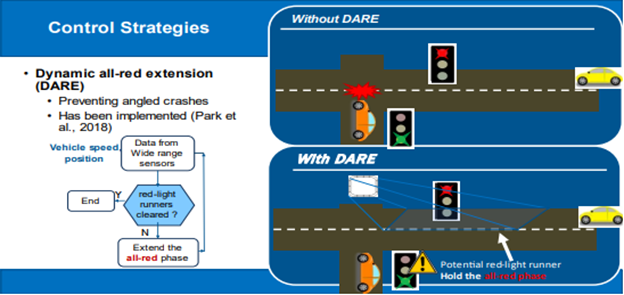The dilemma zone of a high-speed intersection represents the area in which the onset of a yellow light leaves a driver unsure of whether it is preferable to attempt a stop or proceed. This uncertainty greatly increases the likelihood of an accident, taking the form of a rear-end collision should they mistakenly stop, or a right-angle crash should they mistakenly proceed.[i] The MDOT State Highway Administration’s Office of Policy and Research requested assistance in researching and developing a solution to this problem, entering a 5-year contract with the University of Maryland’s A. James Clark School of Engineering. With federal research funding, the research team developed the Integrated Intelligent Intersection Control System (III-CS) tool, serving as technical advisors in its state-funded implementation on Maryland’s Interstate 95.[ii]

A graphical depiction of the DARE algorithm as executive by the III-CS tool. Source: Chang, G.-L., Chen, Y.-H., & Cheng, Y., 2022
The III-CS builds on concepts implemented in the state’s already existing dilemma zone protection system (DZPS). Making use of components including wide-range vehicle sensors, III-CS can track the speed evolution of vehicles in the 600-1,000-foot range, providing signal phase and timing (SPaT) data to in-cabinet computer capable of implementing demanded control algorithms – altering intersection light timing to maximize safety. The earlier phases of this project saw the development of a dynamic all-red extension (DARE) strategy, with similar systems deployed both in and outside of the United States with some success. Under DARE, should sensors detect a vehicle perceived as likely to run a red light, the perpendicular light will receive a signal to prolong its own red until the intersection is cleared, protecting drivers from a potential angled collision. The III-CS expands on the DARE mechanic with two additional algorithms, allowing green-light extension or termination, as seen in Figure 6. These work under a similar logic, with the objective of minimizing the likelihood of a rear-end collision, just as DARE works to reduce angled crashes.[iii]
Project Purpose
Pre-deployment simulations suggested that the computer’s algorithms would reduce dilemma zone-related collisions in all three of the evaluated intersections. This was supported by the findings after deployment, with the III-CS optimally activating or terminating its green extension to the effect of significantly reducing the number of vehicles trapped in the dilemma zone. This was observed in two studies taking place one and three months after initial deployment respectively. Beyond reducing the number of near conflicts likely to result in rear-end collisions, findings suggested III-CS deployment could positively shape behavior of drivers encountering a yellow light, reduce red-light running and the need for DARE activation, provide additional data for traffic engineers monitoring queue evolution patterns, and even monitor congestion and arterial incidents, all without adding to congestion.[iv] The benefits of III-CS are highest in high-speed areas with relatively low congestion, which applies to a number of rural intersections where challenges of design can complicate measures intended to reduce collision rates.[v]
Outcomes
The algorithms that allow III-CS to improve safety and driver outcomes may be effective at intersections or areas meeting the criteria of high-speed and low congestion. The system operations of III-CS are not published, nor are the published details easily translated into operations. Local, state, and federal agencies interested in applying this technology to their own intersections are encouraged to contact MDOT SHA’s Office of Policy and Research for the in-depth technical information required for implementation. While sophisticated in design, the III-CS is built to be easily used by state- and local-level operators. The research team created a training video instructing said operators in connecting and calibrating the tool to a given intersection.[vi]
In terms of physical resources, the III-CS has several components which must be functional for it to achieve its desired impact. As crashes do not occur every day, it would be possible for the sensors or signal controller to cease functioning without immediate awareness by operators. This necessitates a need to actively monitor the continued functionality and interconnectivity of the equipment, which by nature is low visibility when functioning properly. This is a common vulnerability of automatous and connected systems, warranting upkeep or measures to regularly assess function. To facilitate system monitoring, the in-cabinet computer sends information to its control center on each run red-light.[vii]
[i] Zhang, Y., Fu, C., & Hu, L. (2014). “Yellow light dilemma zone researches: a review.” Journal of Traffic and Transportation Engineering (English Edition), 1(5): 338-352, https://doi.org/10.1016/S2095-7564(15)30280-4
[ii] Personal communication with Dr. Gang-Len Chang, July 2022.
[iii] Chang, G.-L., Chen, Y.-H., & Cheng, Y. (2022). “An Integrated Intelligent Intersection Control System (III-CS) for Safety Improvement and Delay Minimization.” Maryland Department of Transportation State Highway Administration, https://www.roads.maryland.gov/OPR_Research/MD-21_SHA-UM-5-12_Dilemma-Zone-Phase-III_Report.pdf
[iv] Chang, G.-L., Chen, Y.-H., & Cheng, Y. (2022).
[v] Maze, T. H., Hochstein, J., Souleyrette, R., Preston, H., & Storm, R. (2010). “NCHRP Report 650: Median Intersection Design for Rural High-Speed Divided Highways.” National Cooperative Highway Research Program, link
[vi] Chang, G.-L., Chen, Y.-H., & Cheng, Y. (2022). “An Integrated Intelligent Intersection Control System (III-CS) for Safety Improvement and Delay Minimization.” Maryland Department of Transportation State Highway Administration, https://www.roads.maryland.gov/OPR_Research/MD-21_SHA-UM-5-12_Dilemma-Zone-Phase-III_Report.pdf
[vii] Personal communication with Dr. Gang-Len Chang, July 2022.
This report was delivered to the U.S. Department of Transportation in 2023. It was primarily authored by NADO Associate Director Carrie Kissel and NADO Research Fellow Danny Tomares. Many transportation agency staff and others assisted with this project in a variety of ways. We offer deep and heartfelt thanks to all the individuals who have provided information and images, consented to be interviewed, and offered editorial guidance in support of this research. Any opinions, findings and conclusions, or recommendations expressed in this publication are those of the authors and do not necessarily reflect the views of U.S. DOT or the NADO Research Foundation.
To read more about the NADO Research Foundation’s ITS case studies, follow this link.


